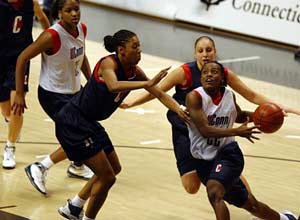

S O C I E T Y
Now She's Got Game: Title IX helped more women get into sports, but opponents complain it's pushing men out
By MICHELE ORECKLIN

Monday, Feb. 24, 2003
Gampel Pavilion on the University of Connecticut's campus can seat 10,000 people, and every time the women's basketball team plays there, the place sells out. At a recent home game against Seton Hall University, UConn's athletic director, Lew Perkins, surveyed the cheerleaders, the band, the students with their faces painted in the team's colors, the dancing Husky mascot and sports reporters from publications not normally inclined to cover women's college athletics. "This turnout has nothing to do with Title IX," Perkins remarked, referring to the 1972 law that requires schools receiving federal funds to offer equal opportunities to men and women. "These people are here because our women's basketball team is so great."
It should be noted that Perkins has demonstrated strong support for Title IX and worked strenuously to bulk up women's athletic participation at UConn. His comment reflects the pride he feels in the team, which has become almost more popular than the men's squad. A national phenomenon and a school obsession, the women Huskies have won a record 64 straight games, most often crushing the opposition, as they did Seton Hall a few weeks ago.
But doesn't Title IX count in the team's success? Would the school have allotted the resources, facilities, equipment or salary for a first-rate coach to develop the program if it had not been mandated to do so by law? And without Title IX to mandate opportunities for female athletes in high school, would UConn have found players primed to succeed at the college level?
When Title IX was written, it was clear that women needed help to achieve equality on the playing field. But 31 years later, some question whether the legislation has worked too well and promoted women at the expense of men. Under the law, a school can demonstrate Title IX compliance in one of three ways: by making the percentage of female athletes the same as the percentage of female students, by showing an ongoing history of increasing opportunities for women, or by showing that it is accommodating the interests and abilities of women.
It is the first option, the proportionality test, that gets Title IX critics in a lather. Many schools believe that this is the only sure way to avoid accusations of noncompliance, since progress can be measured in hard numbers. But detractors say it leads to dismantling men's teams while adding women's as a school attempts to meet its goals. UCLA and the University of Miami have eliminated their men's swim teams, even though both regularly sent competitors to the Olympics. In 1997, Boston University dismantled its football program, which had been around for 91 years, and in 1999, Providence College ended its popular baseball program. "Title IX benefited women who were discriminated against," says Jessica Gavora, author of Tilting the Playing Field. "But now it is being used as a preference, not a shield against discrimination."
In perhaps the most frequently cited of these trade-off cases, Marquette University decided to end its wrestling program in 2001, even though the team was primarily supported by private donations. The school said it was trying to create parity between the total number of spots for women and those for men. This was one of the cases that led the National Wrestling Coaches Association to file a lawsuit against the Department of Education, claiming that Title IX was unlawful and encouraged "gender quotas."
Few words are more likely to get the Bush Administration's attention than "quota." So last June, U.S. Education Secretary Rod Paige appointed a 15-member Commission on Opportunity in Athletics to consider changes to Title IX. The move dismayed the law's defenders, who believe that the White House is intent on rolling back years of gains. During his campaign for President, Bush said he was against "strict proportionality" in Title IX. And last year he appointed affirmative-action opponent Gerald Reynolds to head the Office of Civil Rights, the department charged with overseeing the law's enforcement. The commission is scheduled to make its recommendations to Paige this week, though he is not required to take any action.
The proposals under consideration include changing the proportionality test by giving half the number of athletic spots to men and half to women, regardless of the ratio of men to women in the student body; allowing institutions to count the number of slots available on each team, as opposed to the number of people actually playing; and excluding walk-ons, or students who do not receive scholarships and therefore are not supported by the athletic budget, from participation totals.
Supporters of Title IX say none of these recommendations are necessary and the law is being used as a scapegoat for schools that have exercised poor fiscal management over their athletic budgets. "On too many occasions, schools that have cut teams have blamed Title IX," says Lamar Daniel, who consults with schools on Title IX issues. "At those institutions that I have worked with, lack of money has been the primary reason for cutting teams." Women's advocates point to the bloated size of men's football teams. If, for example, proportionality requires a school to offer only 100 slots for men's sports and a football team takes up 85 of them, that leaves fewer slots for less fan-friendly, non-revenue-producing men's squads such as gymnastics and swimming. "The attitude for too long was that it was O.K. for women to have equal opportunity only after every boy who wants to has the right to play and never loses that right," says Donna Lopiano, executive director of the Women's Sports Foundation.
Both sides say much discord could be avoided by persuading athletic directors to rely less on the proportionality test and more on one of the two other options for proving compliance."One of the greatest problems is the thinking that proportionality is the only way to reach the goal," says Valerie Bonnette, who spent 15 years in the Office of Civil Rights and is now a private consultant to schools working to achieve gender equity. "Title IX offers enough flexibility that schools have a reasonable choice."
UConn has chosen to rely on the proportionality test, and to a large extent, it has proved successful. But it has taken years and lots of careful diplomacy to balance the scales. In 1995 Lew Perkins commissioned an evaluation to see how the athletic department was faring. "I wanted to make sure we were doing things the right way," he says. It was also a time when the school was attempting to upgrade its football team to Division 1A status, which would mean adding 22 scholarships for men. Perkins learned that although women made up 51% of the undergraduate population, they composed only 38% of the athletes. Working with an outside consultant, the university devised a five-year plan to reach compliance. It involved adding three women's sports — lacrosse, ice hockey and crew. But rather than cut any men's sports, it capped the number of players who could be on those male teams, a practice known as roster management.
The school also went out and raised enough money so that its budget could accommodate adding women's sports without subtracting men's. It was helped in this by the fact that there are no professional sports teams in Connecticut, making Husky teams literally the only game in town. The state has been generous, and among other things, is helping pick up the tab for a new football stadium, which will be ready for opening day this fall. Additionally, the women's basketball team is one of only a handful in the country that make money from a contract with Connecticut public television and ticket sales to its sold-out games. Today UConn's athletes are 52% female and 48% male, almost exactly the percentages of its undergraduate enrollment.
Still, UConn's approach has not been entirely without friction. Prior to 1997, the men's and women's crew teams were club sports, meaning they were not financially supported by the athletic department, did not participate in NCAA-sponsored competitions and were not included in the school's Title IX compliance numbers. But when the women's team was upgraded to varsity level, it received new boats, uniforms and a travel budget, while the men got nothing. The men's team had owned the lease on the boathouse that the two rowing squads shared, but the university purchased it for the varsity women's use and asked the men to move. The male rowers have protested, and the matter is still being resolved. In the meantime, the men have been cordial. "Some people say we're suffering from reverse discrimination, and I tend to agree," says Derek Dilaj, a junior member of the crew team. "At the beginning, there was some friction and resentment, but it's not the girls' fault. They didn't make the decision."
Then there are issues that may be more difficult to overcome than who gets to use the boathouse. For instance, it's still hard to recruit enough women players, and it seems that those who do sign up are less willing than men to "ride the bench," or sit on the sidelines while the stars play. Says Pat Babcock, UConn's senior administrator for women's sports: "We ask our women's coaches to carry a lot of players, but the five or six who don't get into an event are apt to go off and do other activities rather than stay on a team for which they don't get to participate." Heather Linstad, the women's ice-hockey coach, who came to the school in 1997 when the team became a varsity sport, says there's an understandable reason for that. "It's not that they're less interested. It's just that there's no long-term benefit," says Linstad, referring to the fact that there are few ways for women to capitalize on their college athletic careers as there are no professional leagues for women's ice hockey.
The success of the WNBA has made postcollege possibilities for players on the women's basketball team much brighter. However, Chris Dailey, the associate head coach, says she wonders if the players appreciate their good fortune. "I had a discussion with the team the other day about Title IX, and in all honesty, I was a little disappointed," she says. "For them, the opportunity has always been around. They're sharing equal time in the gym with the men. Their games are sold out. I'm not sure they understand what other women had to go through." Or if the law changes, what it may be like for the women coming behind them.
From the Mar. 03, 2003 issue of TIME magazine
The End